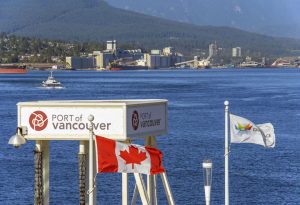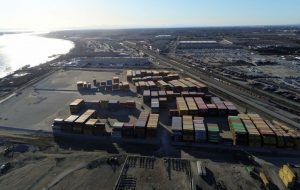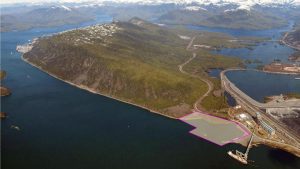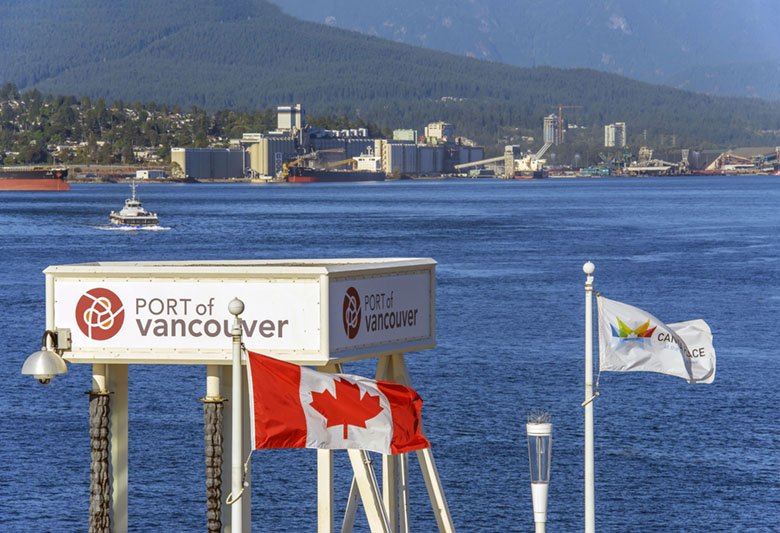
It still surprises some people when they learn that the third-biggest and busiest seaport in North America—after Los Angeles and Long Beach—isn’t in California or Washington, but in the Canadian province of British Columbia.
But it’s true: The Port of Vancouver, which boasts an overall size of 217.5 miles (350 kilometers), a land area of 1,000 hectares (2,471 acres) and a 16,000-hectare (39,536-acre) harbor, is the largest, busiest port in Canada.
With a draft depth of 18.4 meters (60.3 feet) and 57 available berths, the POV is capable of accommodating some of the biggest container ships in existence.
However, it isn’t the only port in the province of British Columbia. The Port of Prince Rupert also has shipping import and export facilities.
And like other seaports along the West Coast, the British Columbia ports have dealt with some major adversities over the past couple of years, most of them COVID-related, but have also managed to make strides in infrastructure improvements and increasing their market share.
Here’s a look at some of the important goings-on at the two ports over the past year-plus.

Port of Vancouver
Last year, cargo volumes through the port increased by 1% from 145 to 146 million metric tons over 2020, port data show, with the amount aided by record container and foreign bulk volumes, as well as strong grain volumes in the first half of 2021. These factors helped maintain cargo volumes through the port, despite challenges presented by the COVID-19 pandemic.
However, following eight straight years of record grain volumes and a 2021 mid-year record of grain shipped through the port, 2021 grain volumes declined by 13% over 2020 after a drought in Western Canada diminished Canadian grain production in the latter half of the year.
Port terminals mitigated volume reductions, according to port officials, by drawing down and shipping stored grain, ending the year with the second-highest annual grain volume in Port of Vancouver history.
Declines were also seen in sectors such as fertilizers (down 13%), chemicals (19%), lumber (14%), wood pulp (20%), and processed food products (22%), due to what port officials say was a combination of global supply chain challenges and weather events.
Continuing a long-term growth trend in container trade, shipping container quantities moved through the port reached a record 3.7 million twenty-foot equivalent units (TEUs) last year, a 6% increase over the previous year.
“The 2021 container story, while a record for the fifth year in a row, is a warning on two fronts: a looming container capacity shortage and the Lower Mainland’s industrial land shortage crisis,” said Robin Silvester, president and CEO of the Vancouver Fraser Port Authority, the federal agency that manages trade through the Port of Vancouver.
Container trade through the Canadian West Coast has been growing at an average of 5% annually for the last decade, in line with the high case of forecasted growth, according to port data.
With continued growth, West Coast terminals are expected to run out of capacity by the mid-to late-2020s. To meet increased demand for goods shipped in containers, the Port Authority has been leading the Roberts Bank Terminal 2 Project, a proposed container terminal in the British Columbia city of Delta.
The proposed $3.5 billion project, which would be paid for by a combination of port authority funds and private investment, would aim to increase container capacity on the West Coast by 30%. It has been designed to incrementally deliver a total of 2.4 million TEUs of capacity at the POV. As of early May, the project was still pending a decision by the federal government before it can proceed.
“Globally-based supply-chain problems that Canadians are experiencing now are a preview of made-in-Canada supply-chain problems that are heading our way in a few years if, as a country, we don’t deliver urgently needed container terminal capacity,” Silvester remarked. “That’s why the port authority is leading the Roberts Bank Terminal 2 Project. This project would be foundational to Canada’s trade future, but if we don’t act, it’s ours to lose.”
In other news, in April the port re-opened its cruise terminal after it being shuttered for two years due to COVID. The inaugural visit of the Holland America Line ship, Koningsdam, occurred at the port’s Canada Place cruise terminal on April 9.
Before the pandemic, the port had welcomed cruise passengers to Vancouver for more than 40 years. But that changed in March 2020 when, as part of its COVID-19 response, the Canadian government temporarily prohibited cruise ships in Canadian waters.
That prohibition was lifted in November 2021, but Under Transport Canada requirements, cruise passengers must be fully vaccinated against COVID-19 and test negative for COVID-19 before boarding ship.
This year, more than 300 cruise ships are expected to call at the Port of Vancouver, representing an increase of about 8% in cruise ship visits from 2019.
“A tremendous amount of care and consideration has gone into planning this restart, under our federal health framework, to help ensure the safety of passengers, crew and the community,” Silvester said.
In 2019, each cruise ship that called at Canada Place generated an estimated $3.17 million in direct economic activity and the industry generated $2.2 billion in total economic impact that year, according to the Port Authority.
“The return of cruise ships to Canada is a significant milestone in restarting our economy and reopening our tourism sector,” federal Minister of Transport Omar Alghabra said.
In mid-November of last year, severe flooding in B.C. completely cut off rail service connecting the Port of Vancouver to national supply chains for eight days, exacerbating global supply-chain challenges that have been affecting Canadians throughout the COVID-19 pandemic.
The floods hastened work to improve B.C.’s supply chain capacity, including the addition of 40 acres in the Fraser Richmond Industrial Lands for cargo container storage. The Government of Canada provided $4.1 million in the wake of B.C. flooding, to help the port authority prepare the 40 acres as a short-term empty container storage location.
The site supports Canada’s supply chain by mitigating terminal congestion resulting from the storage and handling of empty containers.

Port of Prince Rupert
The Port of Prince Rupert, which is located about 1,500 kilometers (932 miles) north of the POV, is the country’s third-busiest seaport, after Vancouver and Port of Montreal.
In CY 2019, the last pre-pandemic year, Prince Rupert had a cargo tonnage of 29.84 million metric tons and a container volume of 1.21 million TEUs, according to port data.
And despite the pandemic, Prince Rupert had a bustling 2021, with the year serving as a significant period of construction and investment, including completion of several infrastructure projects. Among them:
Commissioning of an LPG terminal in the first quarter of the year, and an inaugural outgoing shipment of liquified petroleum gas in April 2021.
The launch of the Fairview Container Terminal Expansion Project in Q1 2021, and the expansion of the container yard with major infill work at the south end of the terminal The project is expected to bring new capacity online by July 2022, and eventually bring the terminal’s overall capacity up to 1.8 million TEUs by the end of 2023.
The Fairview-Ridley Connector Corridor, including intermodal rail siding expansion and a haul road that will enable container truck traffic to be rerouted away from public roads with a corresponding 75% decrease in distance and air emissions, substantially completed construction in 2021 and is expected to be commissioned this July.
In October 2021, Wolverine Terminals Inc. announced the start of construction of a marine fuel terminal that would provide new marine fuel distribution services at the port.
The Ridley Island Export Logistics Project, a project that would support large-scale export transloading.
Additionally, past February the port announced that it intended to double its capacity by adding a second container terminal. The potential project would add up to two million TEUs of annual capacity to the port, officials say.
DP World, a global leader in logistics and provider of smart supply chain solutions, and the Prince Rupert Port Authority have entered into a two-year agreement to assess the feasibility of an innovative new container terminal project in Prince Rupert.
“This agreement is a clear demonstration of our commitment and confidence in the viability of a second terminal at the Port of Prince Rupert,” Maksim Mihic, CEO and General Manager of DP World (Canada) Inc. said. “Our vision for this proposed project will ensure the Canadian trade and supply chain landscapes are future-proofed.”
“A second container terminal will help consumers, exporters and industries across the country while continuing to contribute significant economic benefit for local communities, the broader region and our Indigenous partners,” Prince Rupert Port Authority President and CEO Shaun Stevenson remarked.
The expansion plans are despite the port experiencing a decline in cargo volumes in 2021.
Last year, Prince Rupert moved just over 25 million tons of cargo, a 23% decrease in year-over-year total volume from the 32.1 million tons moved in calendar year 2020.
“The shortfall in total volume can largely be attributed to intermodal supply chain disruptions, industry-specific issues, and a competitive West Coast market,” the port said in a statement.
“Given the year that we’ve all experienced in the province of BC with the impacts of extreme weather events, supply chain congestion, and economic uncertainty as a result of the COVID-19 pandemic and its effects, 2021 served to underscore the necessity for additional investment and diversification in the Prince Rupert Gateway to offset trade pattern volatility and shore up the economy against any future supply chain disruptions on North America’s West Coast,” Stevenson said.
“We continue to advance the development of critical infrastructure and expansion projects at the Port of Prince Rupert to best support the resilience, diversification and growth of Canadian trade and supply routes,” he added. “By expanding, we hope to continue be a key economic driver in Northern BC for the benefit of all and will be better positioned to offer Canadian industries supply chain security as the global economy rebounds from the effects of the pandemic.”
2022 is shaping up to be a better year, in part because the port announced in April that like Vancouver, it was also resuming cruises after a two-year, pandemic-caused hiatus. A total of 26 cruise vessels with about 14,010 passengers are expected at Prince Rupert between May and September.
Cruise tourism offers significant economic benefits to Prince Rupert and the surrounding area. Between 2004 to 2019, Prince Rupert welcomed about 655,000 passengers with an estimated direct economic impact of over $50 million, according to port data.
During the last full pre-pandemic year, there was an estimated $1.8 million of economic revenue brought to businesses in the community, port figures show.
Stevenson said that the Prince Rupert Port Authority and its partners are looking forward to safely welcoming back cruise passengers to Prince Rupert after a “de-stabilizing couple of years in the tourism industry.”
“Cruise has historically played a pivotal role in the local economy and it is our hope,” he said, “that the 2022 summer season marks the return of a vibrant local tourism sector, with the opportunity to increase its strength in the future.”

